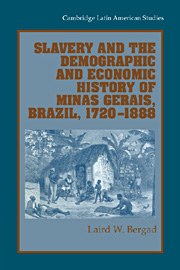Book contents
- Frontmatter
- Contents
- List of illustrations
- List of tables
- Preface
- Acknowledgments
- Maps
- 1 The mining-driven economy and its demise: from settlement to 1808
- 2 Economic transformations, 1808–1888
- 3 Demographic rhythms from settlement to the census of 1872
- 4 Demographic aspects of slavery, 1720–1888
- 5 Economic aspects of slavery, 1720–1888
- 6 Conclusions
- Appendixes
- Glossary
- Bibliography
- Index
1 - The mining-driven economy and its demise: from settlement to 1808
Published online by Cambridge University Press: 16 February 2010
- Frontmatter
- Contents
- List of illustrations
- List of tables
- Preface
- Acknowledgments
- Maps
- 1 The mining-driven economy and its demise: from settlement to 1808
- 2 Economic transformations, 1808–1888
- 3 Demographic rhythms from settlement to the census of 1872
- 4 Demographic aspects of slavery, 1720–1888
- 5 Economic aspects of slavery, 1720–1888
- 6 Conclusions
- Appendixes
- Glossary
- Bibliography
- Index
Summary
It is difficult to unravel the economic history of Minas Gerais during the eighteenth century with precision. There are few reliable sources on production for any time period, although because of taxes levied on gold and diamond extraction during the eighteenth-century boom and after, some approximations may be made for the mining sector, despite unknown levels of smuggling and other forms of fraud. With the decline of mining by the second half of the eighteenth century and the widespread growth of pastoral and agricultural activities, supplemented by small-scale cottage industries in nearly all regions throughout the capitania, the statistical record on production nearly evaporates.
Tax records on trade for the eighteenth and nineteenth centuries exist, and although they may not be used accurately to measure the economic dimensions of interprovincial or internal trade within Minas, they serve as general indicators of economic activity and for some periods provide fairly reliable estimates of trends. Tax data may be supplemented by sporadic information on the physical volume of trade, collected at the many recebedorias, barreiras, and coletorias established along the principal trade routes to and from Minas and reported in official government publications.
The price history of commodities in Minas is unknown, and although there are many references to prices of various products in published and primary source materials for different periods, there has been no effort to systematically collect, present, or analyze them.
- Type
- Chapter
- Information
- Publisher: Cambridge University PressPrint publication year: 1999



